Fog everywhere. Fog up the river, where it flows among green aits and meadows; fog down the river, where it rolls defiled among the tiers of shipping and the waterside pollutions of a great (and dirty) city. Fog on the Essex marshes, fog on the Kentish heights … people on the bridges peeping over the parapets into a nether sky of fog, with fog all round them, as if they were up in a balloon and hanging in the misty clouds.
– Charles Dickens, Bleak House (1853)
I don’t usually begin my exhibition reviews with a literary quote, but the iconic opening lines of Charles Dickens’ Bleak House kept echoing in my mind on my visit to the latest exhibition of Claude Monet’s works at London’s Courtauld Gallery: Monet and London: Views of the Thames.
‘Extraordinary’, ‘luminous’, ‘magnificent’: these are all words which Monet used in his letters to describe the London fog. ‘I so love London!’, he writes, ‘but I only love London in the winter … without the fog, London wouldn’t be a beautiful city. It’s the fog that gives it its magnificent breadth. Its regular and massive blocks become grandiose within that mysterious cloak.’
When Monet painted in London, between 1899 and 1901, the city was quite literally coated in a thick mist of yellow ‘smog’ which was a result of the air pollution from the Industrial Revolution. It was considered a characteristic feature. This is why the fog is such an important recurring character in Monet’s paintings, just as it is in Dickens’ Bleak House. However, where Dickens uses that fog as a metaphor for the entropy and murk of nineteenth-century English society, Monet instead transforms it into an ecstatic celebration. ‘The fog assumes all sorts of colours’, he remarks joyfully, ‘there are black, brown, yellow, green, purple fogs and the interest in painting is to get the objects as seen through all these fogs.’
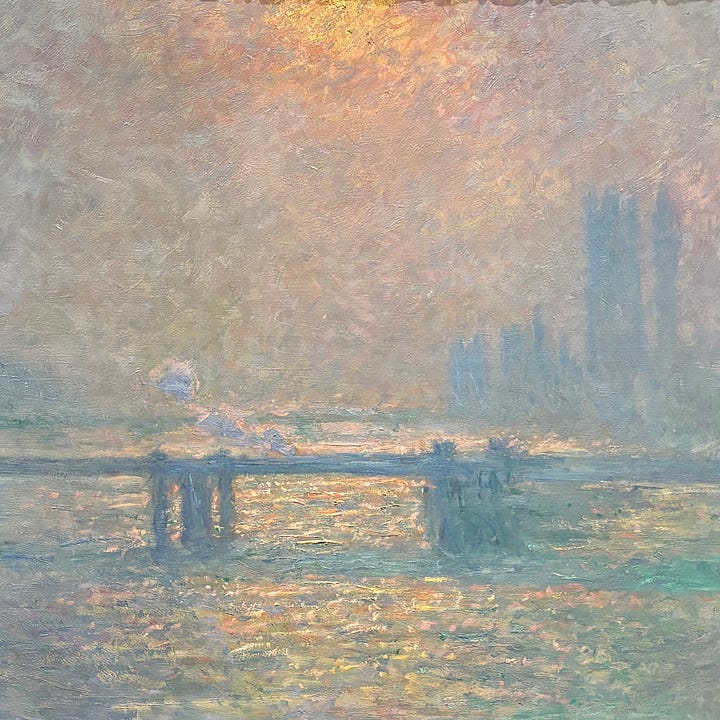
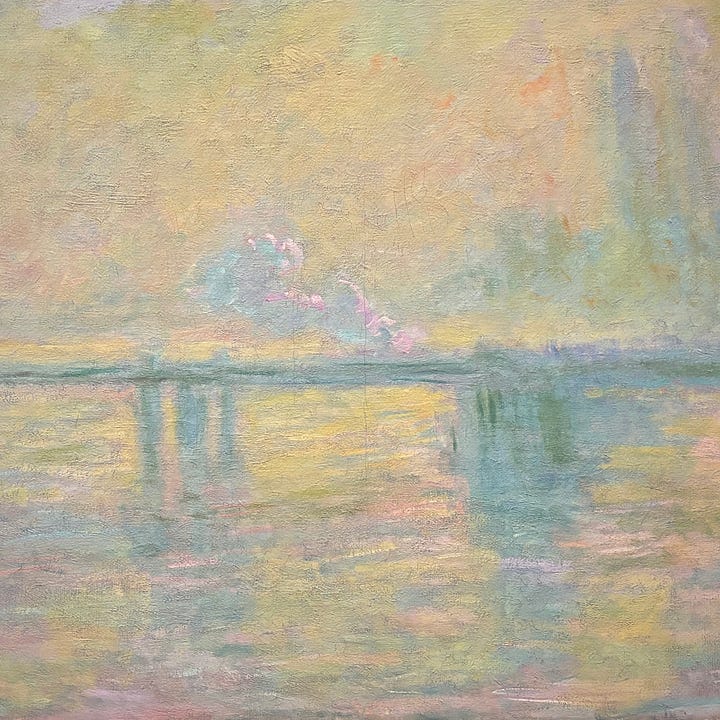
Curated by Dr. Karen Serres, Senior Curator of Paintings at The Courtauld, this exhibition is both illuminating and richly detailed, offering an unprecedented opportunity to see Monet’s definitive London paintings together in a London gallery.
Though Monet originally intended for these paintings to be shown in London, that vision was never realised during his lifetime. Instead, in 1904 he presented a selection at the Durand-Ruel Gallery in Paris which was very popular, and which cemented his reputation as a great artist. This current exhibition aims to bring together a representative collection of those very works Monet chose to showcase. This is something that has never before been attempted!

As I made my way through the two rooms (sold out and bustling with people), I overheard several visitors remarking on how Monet's paintings evoked the hazy expressive seascapes of J. M. W. Turner.
Turner, a prolific English painter of the nineteenth century, marked the beginning of an era in British art that prioritised emotion over naturalism. He laid the groundwork for the abstraction that would come in the next century. Monet's thick, confident brushstrokes and dramatic lighting in these paintings certainly bear a striking resemblance to Turner's style. Yet, interestingly, Monet himself never claimed Turner as an influence. Unlike Turner, who often sought to depict the sublimity of nature, Monet’s approach was, I think, more intimate, joyous, and light.
Perhaps Monet and Turner’s commonalities here lie in their similar approaches: both were pioneers of unprecedented expressive painting techniques; both worked in series; and both focused predominantly on evoking atmosphere instead of being realistic.
This idea of ‘working in series’ is also fundamental to Monet’s artistic practice, and it is a feature of his work which this exhibition really highlights. In fact, although Monet and London contains twenty-one paintings, these are all reinterpretations of the same three places: Waterloo Bridge, Charing Cross Bridge, and the Houses of Parliament.
Monet returned to these locations repeatedly because he was deeply interested in capturing the passage of time through changing effects of light and colour. This is why he liked London so much: because of its ‘idiosyncratic’ climate. He described England as a place full of ‘wonderful things, but none lasting more than five minutes …enough to drive one mad.’
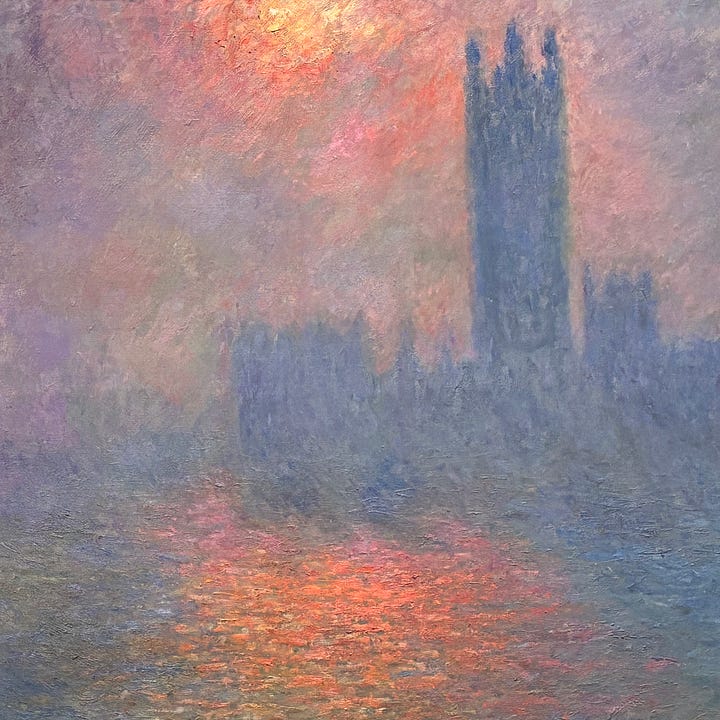
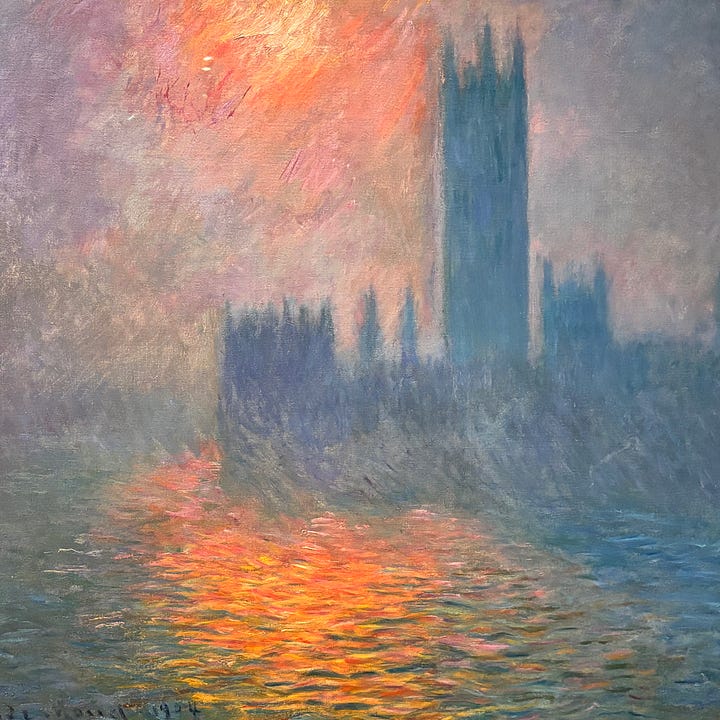
A novel about Monet’s late paintings, Light by Eva Figes 1983 (which I recommended in one of my reading lists), presents Monet as a painter who is utterly obsessed with capturing the transitions between day and night, light and dark. This is an element of his works which Monet and London captures brilliantly.
Claude laid his palette in the bottom of the boat … Something still eluded him, though now, with time running out, he thought he had almost got it. Soon dawn would come, and with it would go this hush, this cool luminosity coming though stillness. It was like sitting in the calm centre of the world and its mirror image, water and sky … his intent eye caught a line of dark blue shadow where the river met, not sky, bit its own reflected shadow.
– Eva Figes, Light (1983)
Light, water, fog: these are the mercurial, dynamic forces with which Monet deals. Where we might see only greyness in the London skyline Monet instead extracts its prismatic hues. His visions of the city are a sumptuous feast of pastel purples, blues, oranges, yellows, and pinks, and they reveal a side of London which the residents rarely get to see: that of an admiring onlooker. Monet marvellously delights in the very thing about which we constantly moan… the weather. He believed that the maelstrom of shifting rain, fog, and darkness were full of creative potential. ‘There is no country more extraordinary for a painter’ — this is what Monet says.
Monet’s Waterloo Bridge c. 1900 exemplifies his romantic view of the city. It features a delicate wisp of marshmallow-pink smoke, enveloped within the blue clouds of London’s industrial south bank. Painted from the vantage point of his top-floor suite at the Savoy Hotel, Monet transformed what many might dismiss as a grimy, polluting eyesore into a poetic vision of modernity. The tendrils of steam, drifting from factory chimneys, seamlessly blend with the fog and mist hanging over the Thames, imbuing the scene with the ethereal beauty that Monet identified with London.
Compare this earlier work with a second painting of Waterloo Bridge from around 1903, three years later. Though the view is the same, the vista is totally transformed. Those pink and lilac wisps have entirely taken over, and they now impart an iridescent sheen to the whole canvas. These pastels totally obscure the powerful chimneys (those markers of industrial progress) in the far background.
On the bottom-right, a small boat glides along the (now very tranquil) Thames. This painting, in its palette, might as well be a painting of a bed of flowers, or the inside of a mother-of-pearl oyster — so silent and contemplative, pink and soft, is it in ambience and tone.
Here we have the same scene again. But where are the pastels? Where are the great chimneys? Instead we are greeted with the ‘little red ball’ (as Monet called it) of the sun, gleaming through a thick blanket of green-grey mist, shimmering its reflection on the water beneath. If you squint, you can see the echo of Waterloo Bridge across the horizon, and two brave little sailboats in the foreground.
The reflections on the water in this painting, along with the spontaneous application of painted highlights, signify Monet’s growing fascination with the fusion between water and sky. This fascination would eventually culminate in his Water Lilies series. Shortly after returning from London, Monet would begin working on these now-iconic paintings in his garden in Giverny, France. This endeavour continued until the end of his life, as he sought to capture the relationship between light, water, and air in increasingly abstract and intuitive ways.
One wonders if Monet’s experiences in London rain played a role in his increasing interest in the capturing the elements: light, water, air, and the boundaries between them. At the very least, the English climate — with its plentiful fog and rain — clearly inspired an exploration of the patterns of shadow, movement, and colour that characterise his later works.
In person, these large canvases pulsate with an intensity that defies digital reproduction. Viewed closely, they dissolve into a chaotic, textured mass of colour, but stepping back brings the scene into focus, revealing a stunning realism. This is the type of exhibition which you need to see in person — so if you’re in London between now and January 19 2025, you ought to have a look. You’ll be just in time for the February fog to roll in.
Fin.


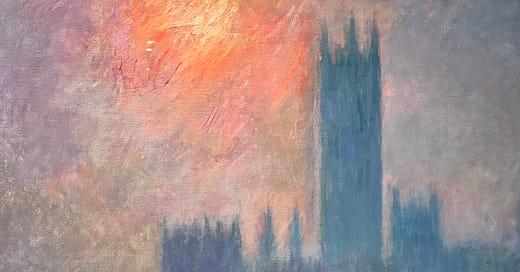



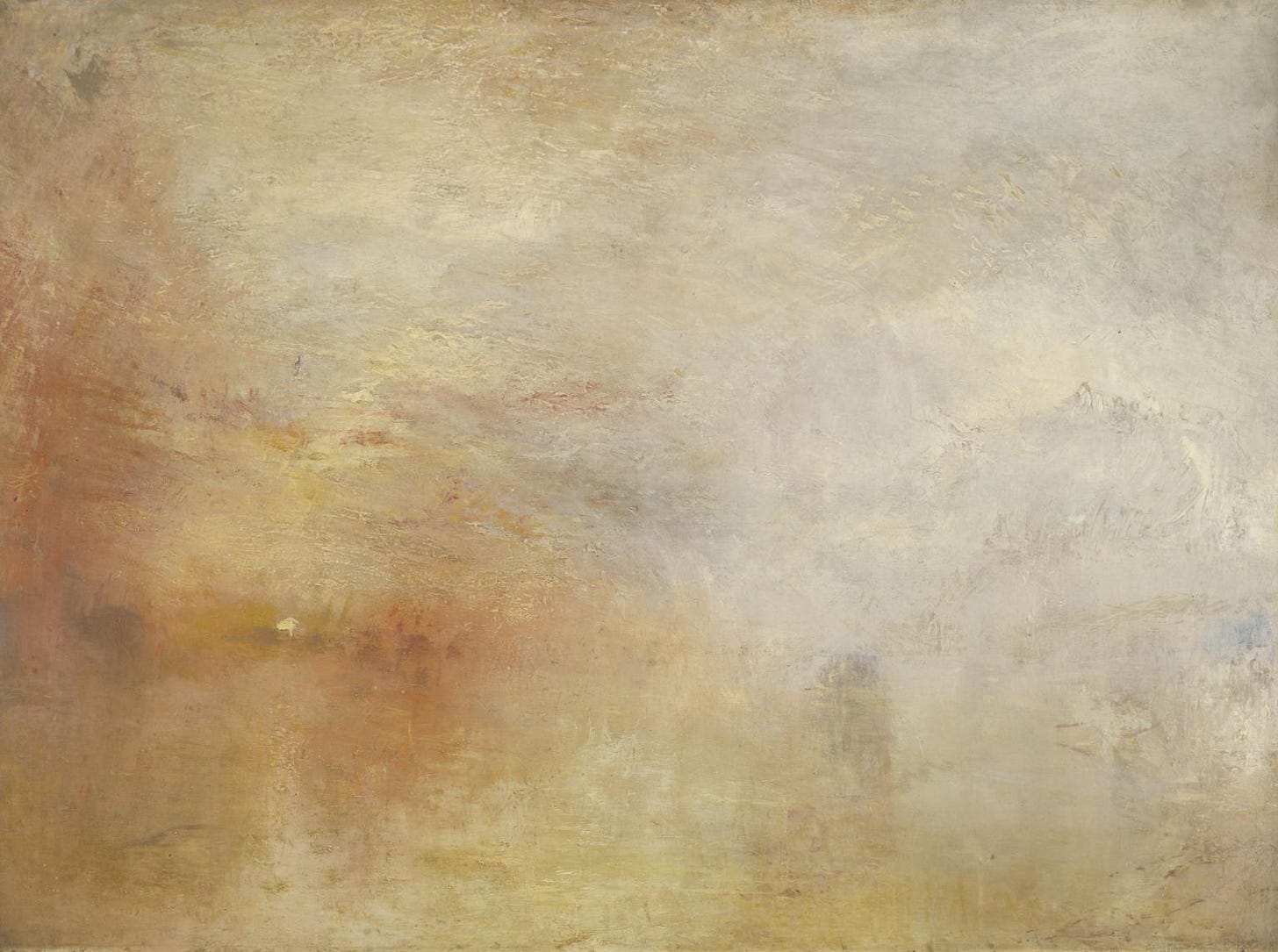
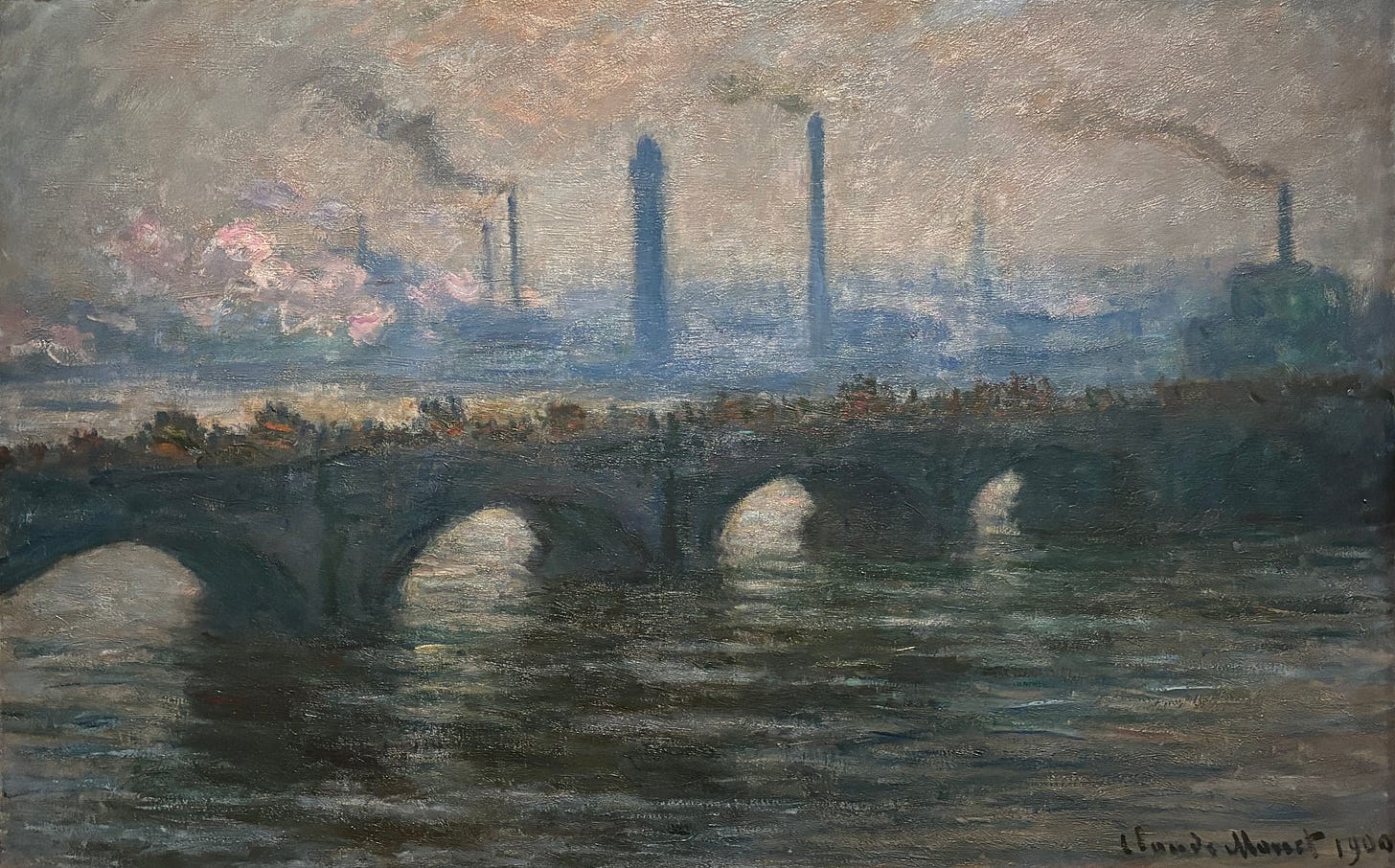

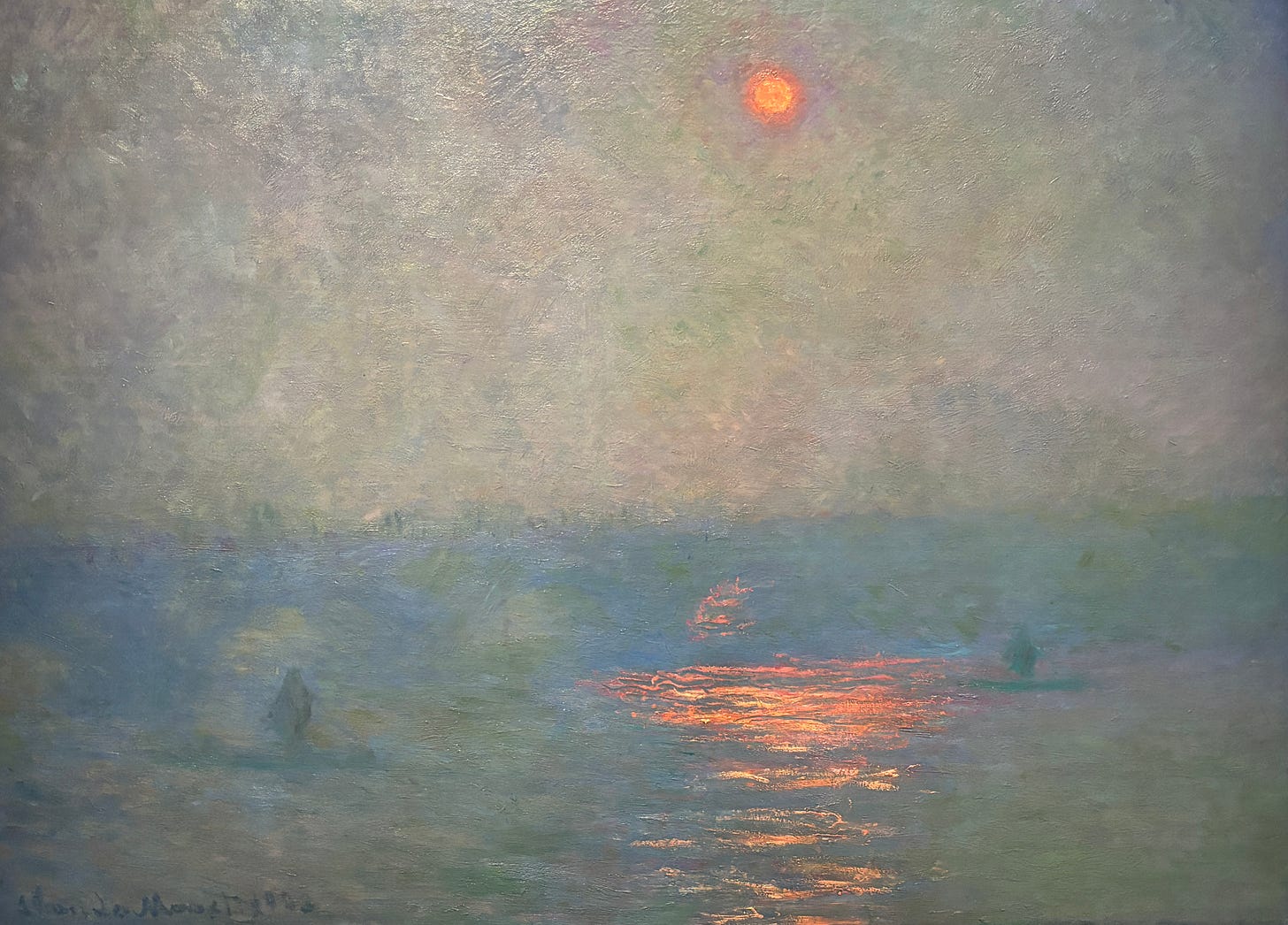

Just another great article 🤷♀️
Thanks for letting us see a bit of this exhibition vicariously through you! What an inspiring collection of paintings. Upon seeing this, it is hard not to get the urge to create - just as I always did when seeing Monet's Rouen Cathedral paintings at the Boston Museum of Fine Arts during my time in Boston.